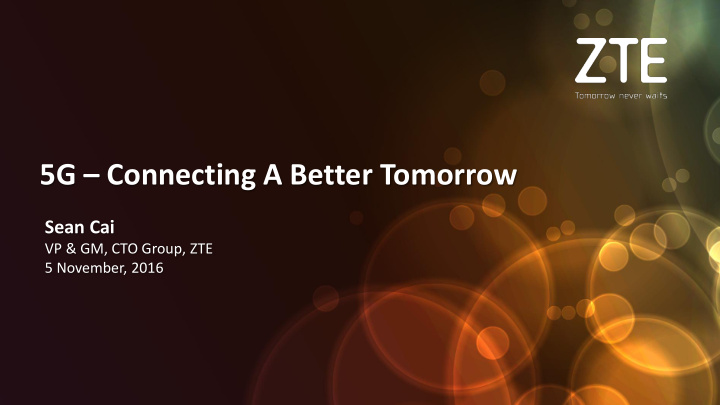



5G – Connecting A Better Tomorrow Sean Cai VP & GM, CTO Group, ZTE 5 November, 2016
Increasingly Connected Lifestyle 2
5G Innovations in Technology, Application & Business Business Models Application Scenarios Advanced Technologies 3
5G Technologies and Cloud Network Architecture Unified Air Interface Cloud-Aware Service Network UAI CAS Unified Design Hierarchy Network for Diversified Service Scenarios with Open Architecture Software Defined Network & Deployments with Flexibility Network Performance Scalable Network Improvement with Generic IT Technology 4
UAI CAS System Design of Unified Air Interface & RAN Service Control Service Convergence Radio resource management & optimization RAN Slicing uRLLC Slice eMBB Slice mMTC Slice Flexible network slicing and virtual resource allocation Multiple Connection, Diversity Massive MIMO (LF & HF), MUSA and Redundancy, Outer Code LDPC, Outer Code Abstract Physical Layer Unified design for all service scenarios and deployments Unified Waveform, Scalable Frame Structure UAI Architecture Proposal for 5G System Architecture 5
UAI CAS Unified Frame Structure for Various Services Optimized Frame Structure by UFS with Flexible Parameters and Configurations • For majority eMBB services, normal frame TTI length should meet the timing and bandwidth requirements • For mission critical uRLLC services, frame TTI length can be reduced to speed up response time, shorten overall latency • For majority mMTC services, when massive connections are required, frame TTI length can be increased to accommodate large number of devices connected simultaneously • Subcarrier spacing is also the parameter for consideration 6
UAI CAS Spectrum Challenges for 5G 1. Over 30 Spectrum Bands for LTE Deployment – Major LTE frequency bands • 700MHz/800MHz/900MHz/1.8GHz/2.1GHz/2.3GHz/2.6GHz • Channel bandwidths: 10MHz/20MHz/others NB-LTE • Possible spectrum re-farming, potential band interference – Smartphone design challenges • GSM/CDMA, UMTS, WiFi, Bluetooth and GPS radio/ band combinations • Challenges of ecosystem & economies of scale 2. FDD/TDD Challenges – Different Carrier Aggregation proposals – Overall ecosystem & global inter-operability between networks 7
UAI CAS Network Development Trend Fast Diversified Customer Much Better Cloud Management Deployment & Service Centric Business Performance Upgrade Scenarios Model VNF VNF VNF VNF NFVI Orchestration Transformation from Traditional Telco Network to Universal Network Platform Function Instance Function Function Instance Function Instance Instance Function Backbone Function Backhaul Instance Instance Access DC with NFVI Edge DC with NFVI Core DC with NFVI Access Node Edge Node Core Node 8
UAI CAS Hierarchy of Cloud-Aware Service Network Network As A Service SDSI Software Defined Service Interface Business Application SDNS Software Defined Create network slices; provide Network Slicing Multi-Layer API Exposure NaaS. Telecom Platform As A Service Business Function SDNF Software Defined Perform NF virtualization; Network Function provide PaaS. Infrastructure As A Service Infrastructure Resource SDI Software Defined Infrastructure virtualization; Infrastructure provide IaaS. CAS Network Architecture Proposal for 5G Networks & Services 9
Thank you
Recommend
More recommend